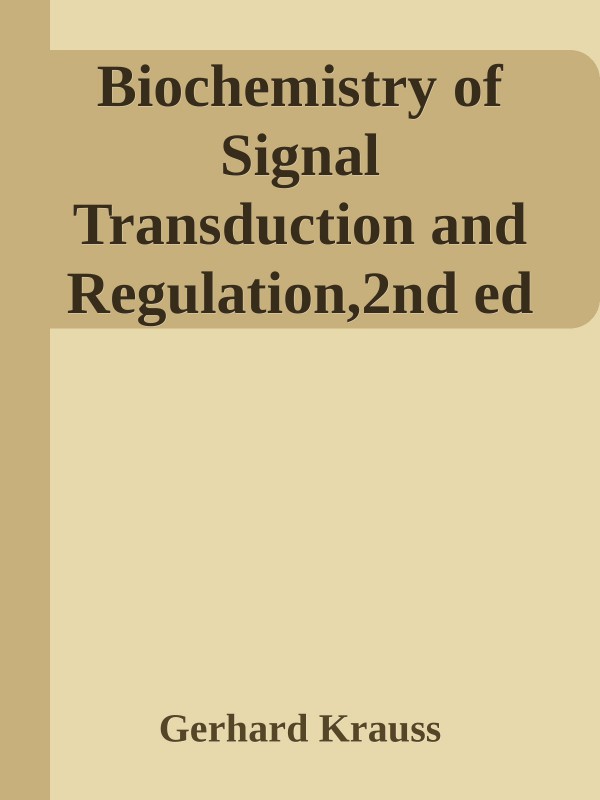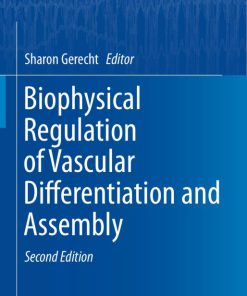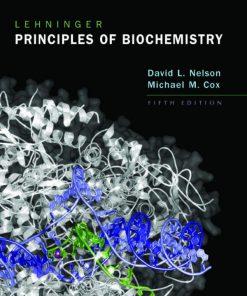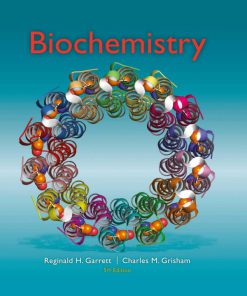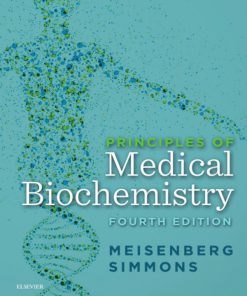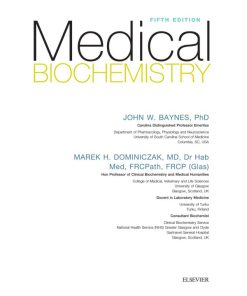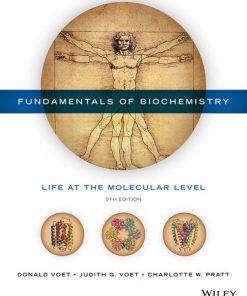Biochemistry of Signal Transduction and Regulation 5th Edition by Gerhard Krauss ISBN 3527667490 9783527667499
$50.00 Original price was: $50.00.$25.00Current price is: $25.00.
Authors:Gerhard Krauss , Series:Biochemistry [42] , Tags:Science; Life Sciences; Biochemistry; Chemistry; Organic , Author sort:Krauss, Gerhard , Ids:9783527313976 , Languages:Languages:eng , Published:Published:Mar 2008 , Publisher:Wiley , Comments:Comments:This all-new edition of a best-selling text has been thoroughly updated to keep pace with the rapid progress in signal transduction research. With didactic skill and clarity, the molecular basis of signal transduction, regulated gene expression, the cell cycle, tumorigenesis and apoptosis is made transparent for everyone with a basic knowledge in biochemistry or molecular biology. “Valuable up-to-date information on biochemistry of signal transduction and regulation” (AFS) “The clear and didactic presentation makes it a textbook very useful for students and researchers not familiar with all aspects of cell regulation.” (Biochemistry) “This book is actually two books: Regulation and Signal Transduction.” (Drug Research)
Biochemistry of Signal Transduction and Regulation 5th Edition by Gerhard Krauss – Ebook PDF Instant Download/Delivery. 3527667490, 978-3527667499
Full download Biochemistry of Signal Transduction and Regulation 5th Edition after payment
Product details:
ISBN 10: 3527667490
ISBN 13: 978-3527667499
Author: Gerhard Krauss
Originally based on a graduate course taught by the author, this true classic has once again been extensively updated to incorporate key new findings in biological signaling. With over half of the content re-written, plus 70 brand new and 50 revised figures, this is the most up-to-date textbook on signaling available anywhere.
Thanks to its clear structure, hundreds of illustrative drawings, as well as chapter introductions and newly added study questions, this text excels as a companion for a course on biological signaling, and equally as an introductory reference to the field for students and researchers. Generations of students and junior researchers have relied on “the Krauss” to find their way through the bewildering complexity of biological signaling pathways.
Biochemistry of Signal Transduction and Regulation 5th Table of contents:
Chapter 1: Basics of Cell Signaling
- Cell Signaling: Why, When, and Where?
- Intercellular Signaling
- Hormones in Intercellular Signaling
- Intracellular Signaling: Basics
- Molecular Tools for Intracellular Signaling
Chapter 2: Structural Properties, Regulation, and Posttranslational Modification of Signaling Proteins
- Modular Structure of Signaling Proteins
- Modular Signaling Complexes
- Regulation of Signaling Enzymes by Effector Binding
- Posttranslational Modifications (PTMs) in Cellular Signaling
- Regulation by Protein Phosphorylation
- Regulation by Protein Lysine Acetylation
- Regulation by Protein Methylation
- Ubiquitin Modification of Proteins
- Lipidation of Signaling Proteins
Questions
References
Chapter 3: Organization of Signaling
- Scaffold Proteins
- Signal Processing in Signaling Paths and Signaling Networks
- Architecture of Signaling Pathways
Questions
References
Chapter 4: The Regulation of Gene Expression
- The Basic Steps of Gene Expression
- The Components of the Eukaryotic Transcription Machinery
- The Principles of Transcription Regulation
- The Control of Transcription Factors
- Chromatin Structure and Transcription Regulation
Questions
References
Chapter 5: RNA Processing, Translational Regulation, and RNA Interference
- Pre-mRNA Processing
- Regulation at the Level of Translation
- Regulation by RNA Silencing
Questions
References
Chapter 6: Signaling by Nuclear Receptors
- Ligands of Nuclear Receptors (NRs)
- Principles of Signaling by Nuclear Receptors (NRs)
- Structure of Nuclear Receptors (NRs)
- Transcriptional Regulation by NRs
- Regulation of Signaling by Nuclear Receptors
- Subcellular Localization of NRs
- Nongenomic Functions of NRs and Their Ligands
Questions
References
Chapter 7: G Protein-Coupled Signal Transmission Pathways
- Transmembrane Receptors: General Structure and Classification
- Structural Principles of Transmembrane Receptors
- G Protein-Coupled Receptors
- Regulatory GTPases
- The Heterotrimeric G Proteins
- Receptor-independent Functions of Heterotrimeric G Proteins
- Effector Molecules of G Proteins
- GPCR Signaling via Arrestin
Questions
References
Chapter 8: Intracellular Messenger Substances: “Second Messengers”
- General Properties of Intracellular Messenger Substances
- Cyclic AMP
- cGMP and Guanylyl Cyclases
- Metabolism of Inositol Phospholipids and Inositol Phosphates
- Storage and Release of Ca2+
- Functions of Phosphoinositides
- Ca2+ as a Signal Molecule
- Diacylglycerol as a Signal Molecule
- Other Lipid Messengers: Ceramide, Sphingosine, and Lysophosphatidic Acid
- The NO Signaling Molecule
Questions
References
Chapter 9: Ser/Thr-Specific Protein Kinases and Protein Phosphatases
- Classification, Structure, and Characteristics of Protein Kinases
- Structure and Regulation of Protein Kinases
- Protein Kinase A
- The PI3 Kinase/Akt Pathway
- Protein Kinase C
- Ca2+/Calmodulin-Dependent Protein Kinases, CaM Kinases
- Ser/Thr-Specific Protein Phosphatases
Questions
References
Chapter 10: Signal Transmission via Transmembrane Receptors with Tyrosine-Specific Protein Kinase Activity
- Structure and Function of RTKs
- Downstream Effector Proteins of RTKs
- Nonreceptor Tyrosine-Specific Protein Kinases, Non-RTKs
- Protein Tyrosine Phosphatases
Questions
References
Chapter 11: Signal Transmission via Ras Proteins
- The Ras Superfamily of Monomeric GTPases
- GTPase-Activating Proteins (GAPs) of the Monomeric GTPases
- Guanine Nucleotide Exchange Factors (GEFs) of the Monomeric GTPases
- Guanine Nucleotide Dissociation Inhibitors (GDIs)
- The Ras Family of Monomeric GTPases
- Raf Kinase as an Effector of Signal Transduction by Ras Proteins
- Further Ras Family Members: R-Ras, Ral, and Rap
- Reception and Transmission of Multiple Signals by Ras Protein
- The Further Branches of the Ras Superfamily
Questions
References
Chapter 12: Intracellular Signal Transduction: The MAP Kinase Pathways
- Organization and Components of MAPK Pathways
- Regulation of MAPK Pathways by Protein Phosphatases and Inhibitor Proteins
- Scaffolding in MAPK Signaling
- The Major MAPK Pathways of Mammals
Questions
References
Chapter 13: Membrane Receptors with Associated Tyrosine Kinase Activity
- Cytokines and Cytokine Receptors
- The Jak-STAT Pathway
- T- and B-Cell Receptors
- Signal Transduction via Integrins
Questions
References
Chapter 14: Other Transmembrane Receptor Classes: Signaling by TGF-β Receptors, TNF Receptors, Toll Receptors, and Notch
- Receptors with Intrinsic Ser/Thr Kinase Activity: The TGF-β Receptor and Smad Protein Signaling
- Receptor Regulation by Intramembrane Proteolysis: The Notch Receptor
- Tumor Necrosis Factor Receptor (TNFR) Superfamily
- Toll-Like Receptor Signaling
Questions
References
Chapter 15: Cell-Cycle Control by External Signaling Pathways
- Principles of Cell-Cycle Control
- Key Elements of the Cell-Cycle Apparatus
- Regulation of the Cell Cycle by Proteolysis
- G1 Progression and S Phase Entry
- Transit Through S Phase and M Phase
- DNA Damage and DNA Replication Checkpoints
Questions
References
Chapter 16: Malfunction of Signaling Pathways and Tumorigenesis: Oncogenes and Tumor Suppressor Genes
- Basic Characteristics of Tumor Cells
- Mutations in Cancer Cells
- Common Physiologic Changes in Tumor Cells: The Hallmarks of Cancer
- Signaling Proteins Mutated in Cancer: Oncogenes
- Tumor Suppressor Genes: General Functions
- Tumor Suppressors: Rb and ARF Proteins
- Tumor Suppressor Protein p53
- Wnt/β-Catenin Signaling and the Tumor Suppressor APC
Questions
References
Chapter 17: Apoptosis
- Overview of Apoptotic Pathways
- Caspases: Death by Proteolysis
- The Family of Bcl-2 Proteins: Gatekeepers of Apoptosis
- The Mitochondrial Pathway of Apoptosis
- Death Receptor-Triggered Apoptosis
- Links of Apoptosis to Cellular Signaling Pathways
People also search for Biochemistry of Signal Transduction and Regulation 5th:
gerhard krauss biochemistry of signal transduction and regulation
biochemistry of signal transduction and regulation pdf
signal transduction pathway biochemistry
what is the role of signal transduction in cell signaling
diagram of signal transduction pathway
You may also like…
eBook PDF
Biochemistry 5th Edition by Garrett Reginald, Charles Grisham ISBN 1133106293 9781133106296
eBook PDF
Banking Regulation and Globalization 1st Edition by Andreas Busch ISBN 0191029866 9780191029868
eBook PDF
Medical Biochemistry 5th Edition by John Baynes, Marek Dominiczak ISBN 0702073016 9780702073014

